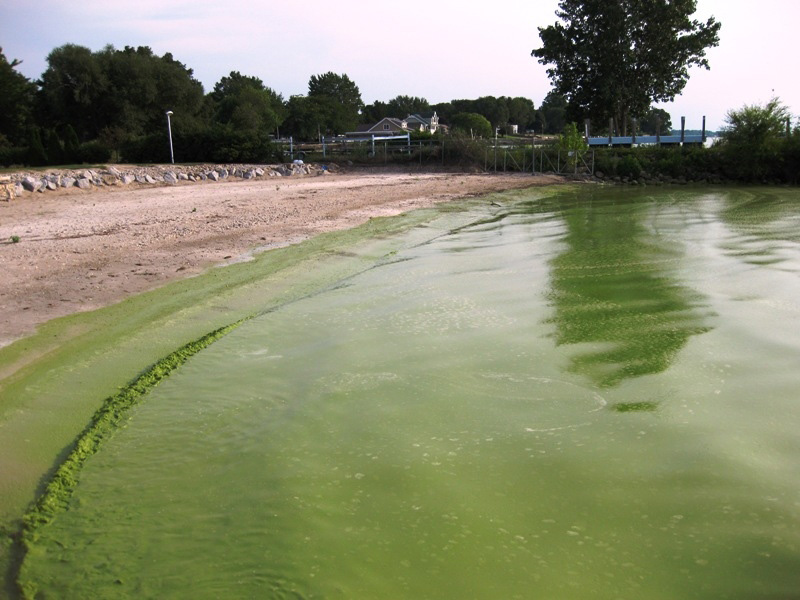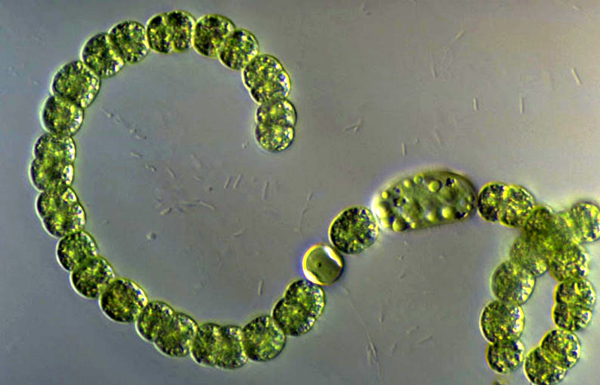“The Rose Cyanobacteria is without an explanation; She blooms, because She blooms” – Angelus Silesius
Our Topical Paleolimnology Arc continues with a look at cyanobacterial blooms. Although we have referred to the relationship between algal blooms and eutrophication in past episodes, our own research has only tangential connections to cyanobacteria. Therefore, we were very pleased that guest host Dr. Liz Favot could bring some expertise to the discussion. Liz currently works with the Federation of Ontario Cottagers’ Associations (FOCA), and is a former colleague from the PEARL lab at Queen’s University, Canada, where her graduate research examined the long-term drivers of recent cyanobacterial blooms in Ontario lakes.
So what are cyanobacteria? They are the Earth’s oldest photosynthetic organisms, an ancient and ubiquitous form of life. Historically, they were referred to as ‘blue-green algae’, but this is an inaccurate name and the root of many misconceptions, as cyanobacteria are prokaryotes, and fundamentally distinct from algal groups such as diatoms and green algae.
Cyanobacteria are typically ignored by the general public until they congregate in large numbers or ‘blooms’. A bloom generally refers to a rapid and visible accumulation of algae and/or cyanobacteria, but there is no standardized definition or measurement associated with the term. Among the ~2700 named cyanobacteria taxa, a few dozen with colonial or filamentous forms can produce blooms in freshwaters, and a few of those can produce Harmful Algal Blooms (HABs).

Cyanobacteria blooms can be harmful to lake ecosystems through oxygen depletion, and the cyanotoxins produced by taxa such as Microcystis and Anabaena can impact human health. Identifying dangerous blooms is difficult, as not all visible blooms are dangerous, and when cyanotoxins are produced, they can remain in the water column long after the bloom itself has subsided. In addition to concerns regarding cyanotoxins, bloom events can also cause taste and odour issues in drinking water. Collectively, cyanobacterial blooms can reduce waterfront property values, creating hesitancy to report them, which in turn can make it difficult to determine whether bloom events are becoming more common.

Blooms are a natural phenomenon; however, it is often unclear whether a perceived increase in frequency is truly an increase above baseline conditions, or simply due to greater attention and monitoring intensity. For example, in Ontario although it seems that bloom frequency is increasing, direct records are not long enough to provide a definitive answer.
Accurate bloom records are also hampered by their ephemeral aspect, as they can range in duration from a couple of hours (dependent on currents) to seasonal to permanent. Whole lakes can be affected or a bloom may be restricted to an individual bay. The chance of capturing a short duration bloom in a remote sensing image is low, when the repeat time can be days to weeks. Therefore, tracking bloom frequency through time requires an approach that uses indirect methods.
So, are cyanobacteria a useful paleolimnological indicator? Kind of. Some cyanobacteria taxa produce resting cysts that preserve well and can remain viable for millenia. However, not all taxa of interest produce cysts, and the conditions that lead to cyst formation are not necessarily the same as those that lead to bloom formation. Furthermore, the relationship between the presence of a particular species and a bloom is unclear. Therefore, paleolimnological investigations of cyanobacterial blooms typically use multiple indicator groups, and focus on blooming probability because they are unlikely to be able to draw a direct line between the abundance of resting cysts or fossil pigments in the sediments and a bloom event.

Liz’s research focused on Dickson Lake in Algonquin Park, Ontario. Interest in the lake stems from an unusual cyanobacterial bloom in 2015 that persisted for the whole summer. A 300 year sediment record revealed no change in diatoms, little change in chironomids and cladocerans, increasing chlorophyll a (suggesting algal production is currently the highest it has ever been), and a spike in akinetes (cyanobacteria resting cysts) at the very top of the core. However, it is still unclear what sets Dickson Lake apart from the other lakes in Algonquin Park.
Blooms are often associated with nutrient enrichment, but in the past 10-15 years there seem to be more blooms in oligotrophic lakes of the Canadian Shield like Dickson Lake where nutrient conditions are not increasing (or in some cases decreasing). Climate warming is believed to be responsible, but the mechanism is unclear. Is it a direct result of higher temperatures? Or perhaps related to a longer growing season and stratification period? Subtle changes in internal nutrient loading? Changes to deep water oxygen conditions? The changes are too recent for clear paleolimnological answers at the moment, but given the amount of research interest, this is an avenue of paleolimnology set for rapid development.

